Tree frogs make up a diverse family of amphibians, with over 800 species worldwide and at least 19 species in the United States. There are 11 tree frogs in Kentucky, including a unique hybrid species. These arboreal frogs have special adaptations like sticky toe pads and long legs that help them climb and jump effectively. However, not all of them live in high treetops.
All these frogs breed near water bodies, making the Kentucky wetland, forests, grasslands, and glade habitats an ideal home for them to reproduce. Read further to delve into the 11 fascinating world of Kentucky frogs, discovering where you can encounter these remarkable amphibians in the Bluegrass State.
11 tree frogs in Kentucky
1. Green tree frog
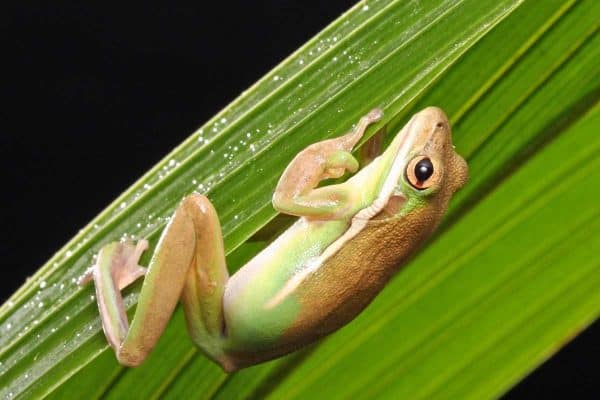
Scientific name: Hyla cinerea
Green tree frogs have smooth, bright green skin with a narrow yellowish to white stripe on each side of their body. Some individuals will also have scattered golden spots or flecks on their back. Their call is a loud and nasally “quank” sound.
They are most commonly found in the wetlands and cypress swamps bordering the Mississippi River in Hickman, Fulton, Carlisle, and Ballard counties. There are also populations along the Ohio River and in the Cave Run Lake area.
2. Eastern Gray tree frog
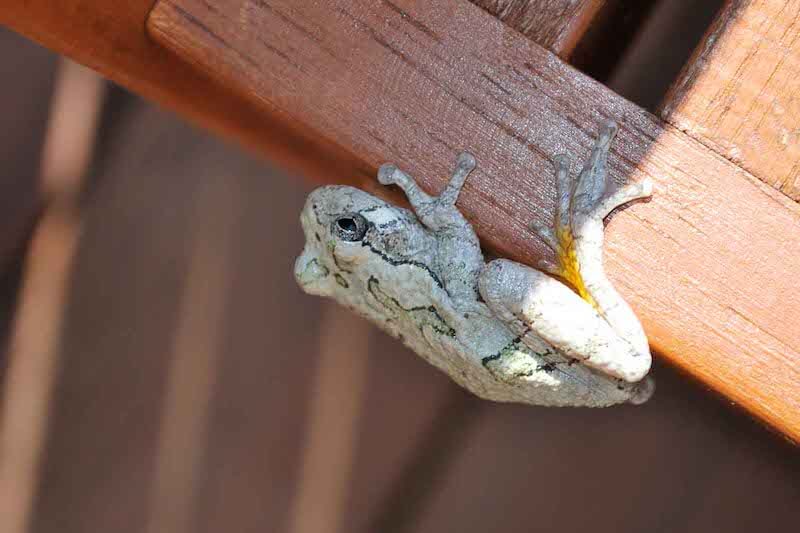
Scientific name: Hyla versicolor
Eastern gray tree frogs are light gray or some shade of green with moist and almost warty skin. The inner thighs’ coloring is marked with irregular orange to yellow spots. They grow just over 2 inches long.
You can find them only in Boyd and Greenup counties in northeastern Kentucky and west in parts of Hardin, Meade, and Breckinridge counties. Their call is a rolling, melodious trill, with the pulse rate slower at lower temperatures.
3. Cope’s Gray tree frog
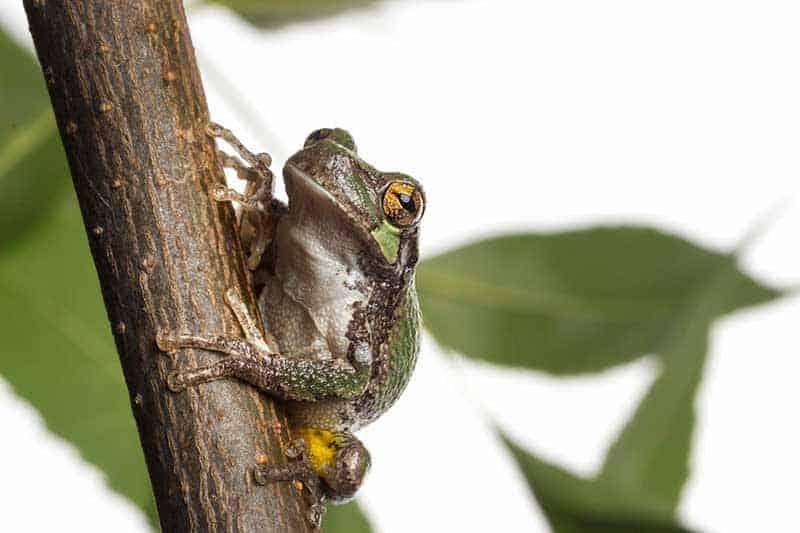
Scientific name: Hyla chrysoscelis
Cope’s gray tree frogs are similar in appearance and size to the eastern gray tree frog. The best way to identify them is by their voice, which is a loud, rapid, and harsh trill that speeds up when the temperature rises.
These frogs can be found statewide in Kentucky. Where their range overlaps with the eastern gray tree frog, you can find the two species sharing the same breeding pond. They are also known to breed in backyard koi ponds, clogged gutters, plastic wading pools, and rain barrels in neighborhood habitats.
4. Bird-voiced tree frog
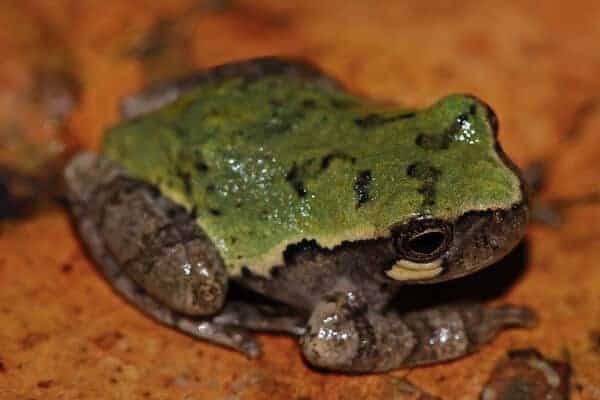
Scientific name: Hyla avivoca
Bird-voiced tree frogs are dark green or pale green to gray or brownish. Their skin is slightly granular and pebbly and the inner thigh has irregular pale green spots. They have a call that’s a high-pitched whistle lasting several seconds.
In Kentucky, you can find them in the Western Coal Field and Jackson Purchase regions. They are mostly in high trees in flooded bottomland hardwood forests and cypress swamps. These frogs only come down from the trees during the breeding season to mate near standing water.
5. Hickman hybrid
Scientific name: Hyla avivoca
Where the Cope’s gray tree frog and bird-voiced tree frogs range overlaps, these two species will sometimes interbreed. The resulting offspring are called the Hickman hybrids, looking nearly identical to both parent frogs. However, the inner thigh coloring ranges from a greenish-yellow to pale yellow.
In Kentucky, you can find these hybrids in Hickman, Graves, Carlisle, Marshall, and Henderson counties. They have a long and mellow trill that sounds similar to the eastern gray tree frog.
6. Barking tree frog
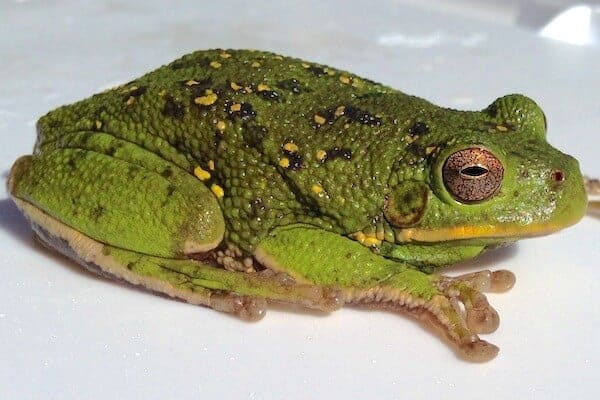
Scientific name: Hyla gratiosa
Barking tree frogs have a slightly pebbly light green to brownish skin with a wide yellowish to whitish band or row of spots on each side. They have a heavier build and unique call resembling a barking dog. They also make a hollow-sounding doonk call during the breeding season.
These frogs can only be found in the Western Pennyrile section of Kentucky, from the southern tip of Livingston County to southern Logan County. They breed in shallow sinkhole ponds in open cropland and pastures.
7. Blanchard’s cricket frog
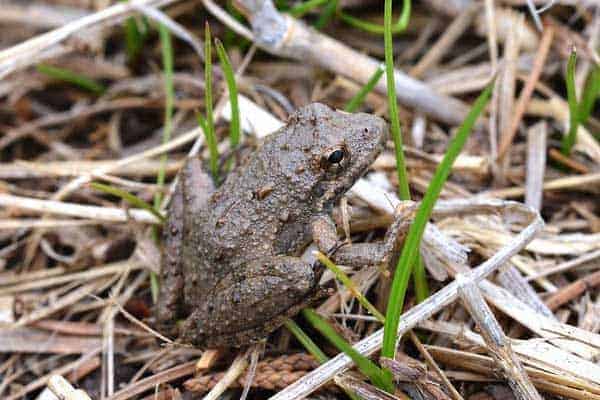
Scientific name: Acris blanchardi
Blanchard’s cricket frogs are small active frogs growing less than 1.5 inches long. They have warty skin that’s brown, tan, gray, or olive green with darker bands on their legs and tiny toe pads. Although incredibly good jumpers for their size, they prefer spending their time in shallow water or on the ground.
There is one population in north-central Kentucky from the Ashland area to the Kentucky River drainage. They prefer weedy shorelines next to ponds, lakes, and streams.
8. Northern cricket frog
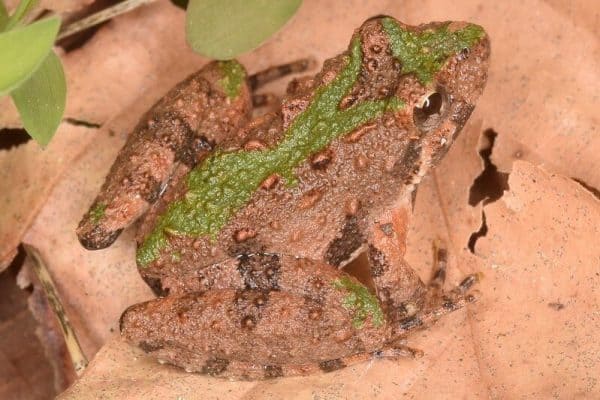
Scientific name: Acris crepitans
The northern cricket frog is brown, tan, greenish tan, or gray, with irregular yellow, orange, brown, or green stripes. Adults average around 1 inch long, with males typically smaller than females.
These frogs are commonly found throughout Kentucky, especially west and south of the Kentucky River drainage. They spend most of their time on the ground and by shallow water bodies like ponds, lakes, and streams. Their call is a series of clicks sounding like two marbles tapping against each other.
9. Mountain chorus frog
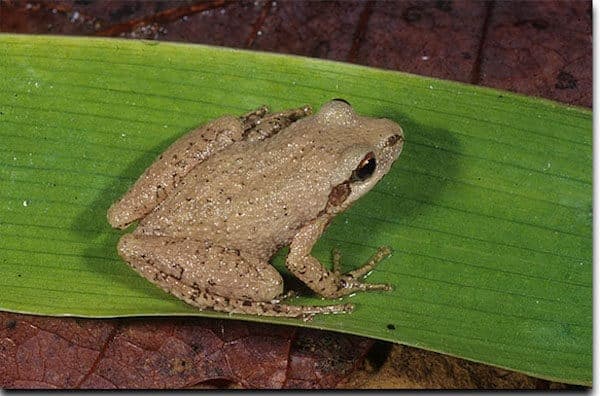
Scientific name: Pseudacris brachyphona
Mountain chorus frogs grow up to around 1.5 inches long and are gray or tan to dark brown. They have a pair of curved “reverse-parenthesis” on their back that sometimes cross to look like an X pattern.
You can find these frogs throughout eastern and southern Kentucky, including the Mammoth Cave National Park. However, they don’t occur in the Bluegrass Region. They prefer temporary woodland pools, but you can also hear their harsh rasping trill from shallow roadside ditches.
10. Western chorus frog
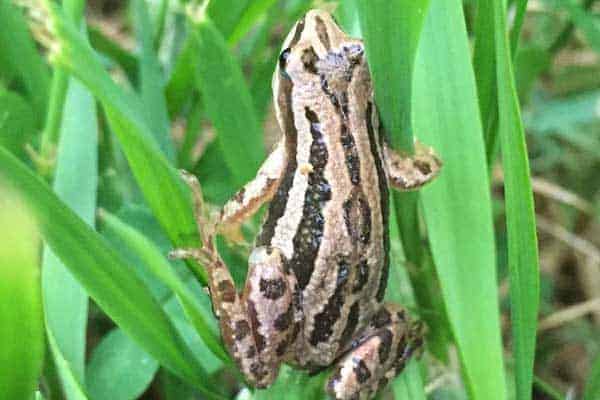
Scientific name: Pseudacris triseriata
Also called the midland chorus frog, the western chorus frog is a fairly large frog growing between 1.5 to 2 inches long. They are greenish-grey, olive, brown, or reddish and commonly have 3 stripes down their backs.
They occur in the western areas of Kentucky in habitats such as grasslands, wetland borders, marshes, forested hillsides, and low wooded areas. You can find them hiding under dense aquatic vegetation during the breeding season.
11. Upland chorus frog

Scientific name: Pseudacris feriarum
Upland chorus frogs, a notable part of the diverse frogs of Kentucky, exhibit a range of earthy hues, including brown, reddish-brown, or gray-brown, adorned with dark blotches. Measuring between 0.75 to 1.5 inches on average, some females can attain a length closer to 2 inches. Their call is almost identical to the western chorus frog, which is a repeated creeek sound like fingers running over comb teeth.
You can find them in shallow pools and wet meadows in southeastern Kentucky and the Jackson Purchase region. They are nocturnal and shy, preferring to hide in lower vegetations and don’t frequently climb high in the trees.



